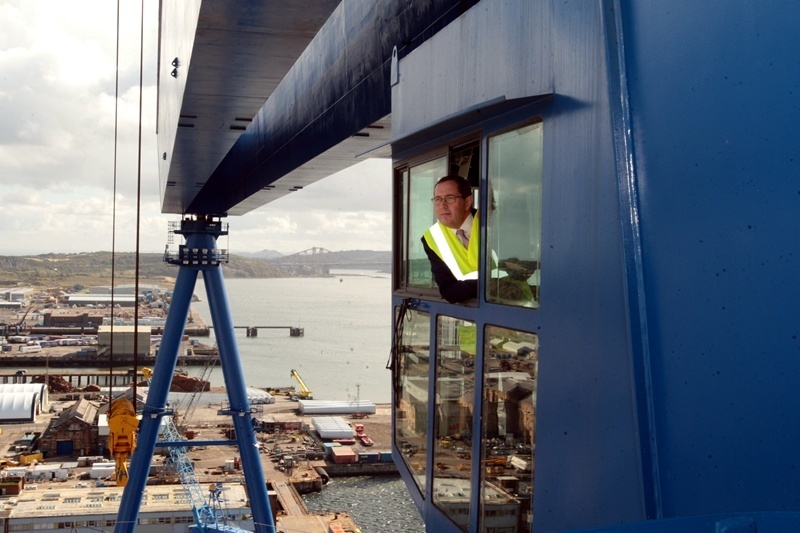Rosyth dockyard is seeing ”history in the making”, according to defence equipment minister Peter Luff.
That is how he described the moment Goliath, one of the world’s largest cranes, completed its final test lift in preparation for piecing together the first of two of the largest warships ever built for the Royal Navy later this week.
From the towering crane which dominates the Forth skyline, Mr Luff had a bird’s eye view of Babcock’s dockyard where the two 65,000-tonne Queen Elizabeth class aircraft carriers are being assembled.
He praised those who will work on what has been described as a giant jigsaw puzzle, with parts fabricated at six UK yards and assembled in Fife.
Mr Luff said: ”This is an exciting week for the carrier programme and it is a huge privilege to witness what can only be described as history in the making.
”The job of building these truly formidable carriers is a huge challenge but we are very fortunate to have such a dedicated and skilled workforce who can rise to this challenge and provide the UK with its largest and most powerful aircraft carriers to date.”
The centrepiece of the construction, an 8,000-tonne hull middle section of HMS Queen Elizabeth, known as lower block three, is already docked and ready for construction, having recently made a 500-mile sea journey from BAE Systems’ Govan shipyard on the Clyde to Fife.
The 90m Goliath crane will lift the first section of the two-deck block, which includes a section of flight deck, on to the seven-deck, 8,000-tonne lower block on Friday.
Sean Donaldson, Babcock QEC project director, said the programme was ”nationally important” and having the infrastructure and facilities prepared at Rosyth ready to support the assembly of the carriers was the result of an immense programme of work and testament to the Aircraft Carrier Alliance’s (ACA) partnership.
”It’s great to see Goliath completing its final test lift and now set for business along with the ACA workforce,” he said.
HMS Queen Elizabeth will be the first of the new aircraft carriers and production of the second, HMS Prince of Wales, began in May.
It is estimated that 7,000-8,000 people will work on the QE Class programme, with a further 2,000-3,000 employed through the supply chain.
A Queen Elizabeth Class carrier will be the centrepiece of Britain’s military capability. It will routinely operate 12 of the carrier variant Joint Strike Fighter jets, allowing for unparalleled ”interoperability” with allied forces.
Each carrier will have nine decks, plus a flight deck the size of three football pitches, and two propellers weighing 33 tonnes nearly two and a half times as heavy as a double decker bus driving the ship at a maximum speed of over 25 knots.
The vessels will form the cornerstone of Britain’s military power overseas, used for operations ranging from providing air support in conflict zones to providing humanitarian aid and disaster relief.
Chief of Defence Materiel Bernard Gray said: ”The Queen Elizabeth Class is a hugely important project for MOD and for the UK’s shipbuilding industry.
”I’m very pleased at this impressive progress on the construction and assembly of first of class.”
Dunfermline and West Fife MP Thomas Docherty added he was delighted Mr Luff visited Rosyth.
He said: ”Peter is hugely respected on both sides of the House of Commons for his approach to defence procurement and he and I regularly discuss the dockyard and Rosyth in general.
”I know that he will be impressed by the commitment and skill of the local workforce.”
